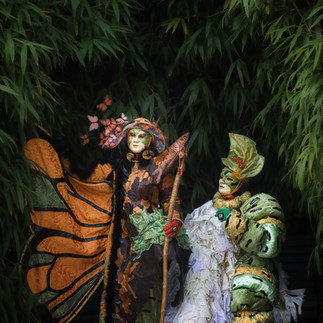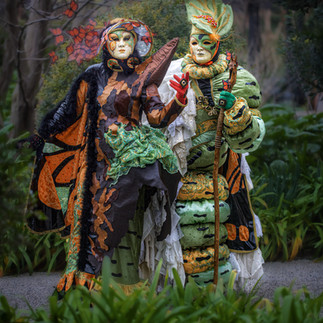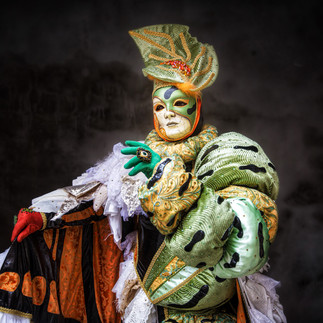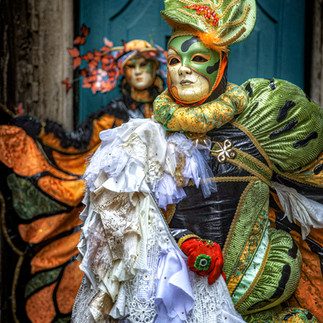Metamorphosis 破繭
- Robin Yong
- 1 day ago
- 8 min read
Updated: 11 hours ago

Metamorphosis 破繭
Metamorphosis is a biological process by which an animal physically develops including birth transformation or hatching, involving a conspicuous and relatively abrupt change in the animal's body structure through cell growth and differentiation.
Butterflies are winged insects from the lepidopteran superfamily Papilionoidea, characterized by large, often brightly coloured wings that often fold together when at rest, and a conspicuous, fluttering flight. The oldest butterfly fossils have been dated to the Paleocene, about 56 million years ago, though molecular evidence suggests that they likely originated in the Cretaceous.
Butterflies have a four-stage life cycle, and like other holometabolous insects they undergo complete metamorphosis. Winged adults lay eggs on the food plant on which their larvae, known as caterpillars, will feed. The caterpillars grow, sometimes very rapidly, and when fully developed, pupate in a chrysalis. When metamorphosis is complete, the pupal skin splits, the adult insect climbs out, expands its wings to dry, and flies off.
Some butterflies, especially in the tropics, have several generations in a year, while others have a single generation, and a few in cold locations may take several years to pass through their entire life cycle.


This is one of my all-time favourite photo projects and masked costume. The Painted Lady butterfly emerging from a cocoon by my Italian friends Marinella and Pasqual. Butterfly masks and costumes are not uncommonly seen at the Venice Carnevale, but I haven't seen anything as spectacular as this one.
Vanessa cardui is the most widespread of all butterfly species. It is commonly called the painted lady, or formerly in North America the cosmopolitan. This is one of the most widespread of all butterflies, found on every continent except Antarctica and South America.
Butterflies are powerful symbols of transformation, rebirth, and hope, representing the journey of self-discovery and the ability to change and evolve, with their delicate nature and immense power inspiring humans for millennia.
The butterfly's metamorphosis from caterpillar to winged creature is a visual representation of change and new beginnings.
Visual artists have been captivated by butterflies' fleeting summertime appearances, delicate structures, and hesitant, careless flight patterns since the 4th century BC. Their transformation from caterpillars is their most captivating ability. For a long time, this act has been interpreted as a sign of beauty transcending baseness. It may simply be a reminder that we still have the capacity to adapt and endure in the twenty-first century.
However, butterflies have also served as metaphors for who we are—more specifically, our inner, spiritual selves. One of the most well-known tales associated with Daoism is Zhuang Zhou Dreams of Being a Butterfly, which was written in China circa 300 BC. Later Chinese and Japanese artists who depicted butterflies used it as a major source of inspiration: Zhuang Zhou once had a dream in which he was a butterfly, fluttering around, content with his life and doing as he pleased. He was unaware of his identity as Zhuang Zhou. He was solid and unmistakably Zhuang Zhou when he abruptly woke up. He was unsure, however, whether he was Zhuang Zhou who had dreamed he was a butterfly or if he was a butterfly who had dreamed he was Zhuang Zhou.
The story's message is to highlight how erratic our mental models are, particularly our ego and reality perception. Daoism places a high value on nature. In order to live in harmony, it emphasizes heeding the "path" or "way" of nature, honoring and adjusting to it. Such ideas seem far-fetched in the modern era. It is evident that the story of Zhuang Zhou's butterfly breaks down the artificial division between nature and humanity. It serves as a reminder of our submissive role in the natural world. By contrasting our fleeting, insubstantial consciousnesses with the greater truth of nature, it upends our conventional sense of being.
A very similar idea had emerged in ancient Greek thought at about the same time, but 5,000 miles to the west. In his treatise The History of Animals (c. 350 BC), Alexander the Great's tutor Aristotle used the word "psyche" for the first time, referring to a butterfly and meaning the human spirit or soul. The idea behind it was that the cocoons of caterpillars were like tombs, and the butterfly that emerged was like the "anima" (soul) escaping the prison of the corpse after death. The goddess of the soul, Psyche, is frequently pictured holding a butterfly in Greek mythology. Since butterflies appeared to be a rebirth of the caterpillar's previously hidden spirit, they were used in Christian art to represent Jesus' resurrection.
"Farfalla" is the Italian word for butterfly. The butterfly's wingspan should be wide enough to touch the tips of two fingers together when placed on either side of it; far falla literally translates to "flutter away." Because they add warmth and sunshine to our lives, butterflies are considered lucky in Italy. In addition to being symbols of change, they stand for joy and love. What matters most about this creature is that it gives us hope in all its manifestations!
The photo series is done in the garden, a bamboo enclave and my "outdoor studio" on the busy streets of Venice using natural lighting only. Usually, I do only one shoot per costume for a model, but after initial Painted Lady shoots at the "outdoor studio", I felt the butterflies needed a more garden background, and ideally a bamboo forest to give it a slight Asian touch. So, I was gave Marinella a surprise call to ask for a second session when I found my little bamboo enclave. If we look at old those old Venetian arts and crafts and jewellery etc, the best ones always have a tough of Asian (usually Chinese or Japanese) and African (Moor/ Blackamoor) touch to them.
This mega photo series has 3 parts to it...Metamorphosis as above and done in the bamboo enclave, Butterflies in the Garden and The Painted Lady...
Butterflies in the Garden 蝴蝶園


There's quite a few gardens and parks in Venice actually, I have used some of these before in previous photo shoots. The butterfly costumes will do well in these gardens, so I brought my Italian friends here. I always like Venetian masks in a garden setting (...in fact I like it so much that I often travelled to Belgium and France to photograph their Venetian themed events at the gardens).
The Painted Lady 小紅蛺蝶



Portraits at my outdoor studio..., the location is very popular amongst my costumed friends. I remember people laughing at us when I was doing photos here a few years back....now everybody wants it. On some days, costumed models were even lining up for it...
The backdrop actually takes on a hue from the color of the costumes, so it technically matches any costume (except for the very big ones that dun fit into this space...)
In this instance, I was hoping for photos with a bit of that noveau art decor feel...
Porta di Atilla 神秘的藍門

Everyone takes pictures of the blue (or perhaps green or turquoise) door that is hidden in a small alleyway in a corner of Venice's Sestiere Castello. Calle de Mezo's renowned "Blue door" (Castello) It must be Venice's most photographed door. It's even marked as a point of interest on Google Maps.
It's a location favored by Atillio Bruni, a famous photogapher in Venice, and one of those backdrops that works well with almost any costume. We came here again this year to get a few souvenir photos because we had a multi-platinum award winning photo done here by myself and Marinella and Pasqual in their Merfolk costume - Scena della mitologia marina con tritone e sirena.
Calle de Mezo - The structure is a stunning Venetian Gothic palace that appears to have been constructed in the early 1400s. Even though it is not in perfect condition right now, it has in the past obviously belonged to someone extremely wealthy.
Nevertheless, it is not identified or mentioned in the general literature on Venetian architecture and palaces. The palace's façade faces the Rio di San Severo, which is home to a number of famous palaces, including Palazzo Grimani, Palazzo Zorzi, and Palazzo Zorzi-Bon. As a result, our palace is surrounded by some of the most distinguished Venetian families. The name of the small alleyway where the blue door is located is the only hint as to the building's identity. The Calle de Mezo is what sounds like a "alleyway in the middle" to a modern ear.
The alleyway is named after the Da Mezzo, a Venetian patrician family. A Chiara da Mezzo informed the Dieci Savi alle Decime, the Venetian Republic's tax authorities, in 1566 that she was the owner of a number of buildings in the S. Maria Formosa district, Ruga Giuffa, and Calle de Ca' da Mezzo. The Ca' da Mezzo, the palace where the family lived, is most likely the owner of the palace with the blue door.
There are usually three doors in a typical Venetian palace. Almost always, the main door is on the water. The façade of Venetian palaces is typically on a canal because the city's elites preferred to travel by boat. On the land side, palaces in Venice would also have a secondary door. Ideally, it would lead to the same corridor as the waterside main door; if not, it would lead to an interior courtyard. Important guests would find both the secondary door on the land side and the front door on the canal side to be presentable.
To put it another way, workers and servants cannot use them. Separate doors, a little off to the side, are for those. Though occasionally found on the waterside as well, a service door is nearly always located on the land side. There are two service entrances on the Ca' da Mezzo: one on the water and another, which is currently closed, on the land side in the Calle del Paradiso, which runs parallel to the Calle de Mezo.
The Blue Door has always remained closed for 99.99% of the time I pass by it (I actually live very close by it when I am in Venice and easily pass by it at least 10-15x a day). I've only seen it open on a couple of locations when construction workers were using it as an access for renovation works. The door must be the land side secondary door given the building's layout, and it appears to lead to an interior courtyard. The same courtyard would be reached by the now-obstructed service door from Calle del Paradiso.
The service door on the canal side, which is now accessible from the base of the contemporary bridge at the terminus of the Calle de Mezo, seems to be the only entrance that is frequently used nowadays. This bridge must be relatively recent because it is not shown on maps from the 1800s or even the early 1900s. The names on the doorbells at the entrance clearly indicate that the palace has now been converted into apartments.
Unfortunately, with Francesco Maria da Mezzo's passing after a nighttime fall in the Rio de l'Arsenal in 1797, the Da Mezzo family went extinct. Even though the local night watchmen who saved him prevented him from drowning, he passed away that same evening, most likely from hypothermia.
Metamorphoses 變形記

The Metamorphoses is a Latin narrative poem from 8 CE by the Roman poet Ovid. It is considered his magnum opus. The poem chronicles the history of the world from its creation to the deification of Julius Caesar in a mythico-historical framework comprising over 250 myths, 15 books, and 11,995 lines.
The Metamorphoses is one of the most influential works in Western culture. It has inspired such authors as Dante Alighieri, Giovanni Boccaccio, Geoffrey Chaucer, and William Shakespeare. Numerous episodes from the poem have been depicted in works of sculpture, painting, and music, especially during the Renaissance. There was a resurgence of attention to Ovid's work near the end of the 20th century. The Metamorphoses continues to inspire and be retold through various media.
The different genres and divisions in the narrative allow the Metamorphoses to display a wide range of themes. Scholar Stephen M. Wheeler notes that "metamorphosis, mutability, love, violence, artistry, and power are just some of the unifying themes that critics have proposed over the years".
I have been using it as an inspiration for my photo work at the Venice Carnevale over the past few years. The world is rapidly changing, and it will continue to do so even more so over the next 20 years. In whatever we do, we need to change with the times. Revolutions, wars etc will all be here soon if they are not already here, but like what my Venetian friends say, we cherish what we have and continue to be beautiful....

















































































Comments